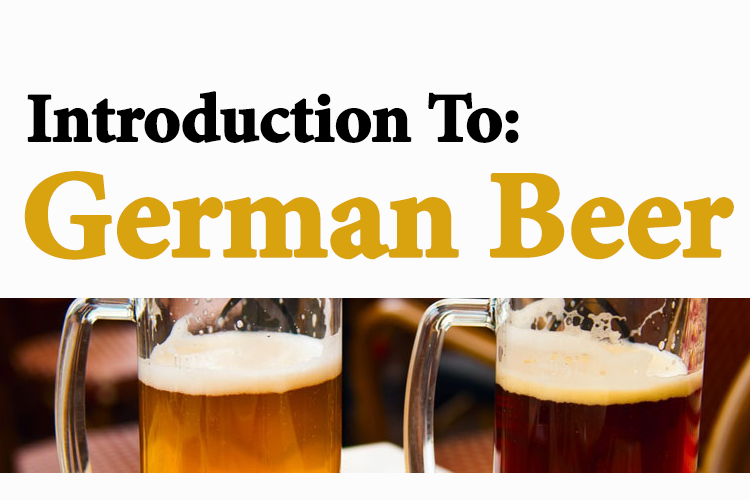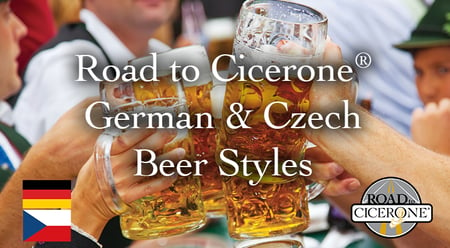
German Beer - The Basics
"The Basics" series of posts from the Cicerone Certification Program introduces various beer topics for those just beginning to learn about the beverage. Those who sell and serve beer for restaurants, bars, wholesalers, importers, and breweries can master these topics with additional training and professional certification through Cicerone.
Germany is well known for its beer culture. Its lagers and ales, and the variations they inspired, are widely consumed all over the world. We'll start this post by focusing on lagers.
Lager brewing had originated by 1600 in and around Munich, located in the Bavarian region of present-day Germany.
At the time, a lack of modern refrigeration and sanitation meant that brewing occurred during the winter season. In the off-season, breweries stored nearly all the beer in cool caves until there was demand for it. This is the origin of the word "lager," which comes from the "lagerung," the German word for "storage." This stored beer still contained yeast, which slowly changed its flavor over time. Today, this process of cold-conditioning a beer is known as lagering and is one of the defining characteristics of the modern lager style.
Lager yeast evolved from the brewing practices used in Germany. Having adjusted to the cool climate of Bavaria, the ideal fermentation temperature for lager yeast is cooler than that of most ale yeast strains. Because of the cooler fermentation and extended lagering period, lagers display little of the fruity esters found in ales. Consequently, the flavors of malt and hops play the primary roles in the overall flavor profile.
German brewers are also known for their ales, particularly those made with wheat. Ale yeast generally produces a class of compounds called "esters," which can impart a fruity flavor to beer. Most German wheat beers also use a type of yeast that contribute "phenolic" flavors to the beer, which taste like clove or nutmeg.
The following are some of the most common German-style beers you'll encounter in many markets.
Weissbier: One of the most popular German beer styles is an ale made with malted wheat. Weissbier has flavors similar to white bread or flour tortilla, with low bitterness and no noticeable hop character. Its key flavors are from the unique yeast strains that contribute banana and clove flavors. German wheat beer brands may be labeled "hefeweizen," "weisse," or "weizen." Most examples of this style have a cloudy, hazy appearance, primarily from the high protein content of the wheat and perhaps some residual yeast. Weissbiers are highly carbonated and traditionally served with an impressive, thick foam head.
Some brands of German Weissbier include Weihenstephaner Hefeweissbier, Paulaner Hefe-Weizen, and Hacker-Pschorr Weissbier.
German Pils: This style gained prominence in imitation of the original pilsner beer from Pilsen in the Czech Republic. The Czech beer was notably hoppy but also featured a rich bready malt flavor with a deep gold color. The German interpretation also emphasizes hop character and a refreshing bitterness. But German-style pilsners are generally lighter in body and color. They showcase German hop flavor and aroma, which comes across as a perfumy, floral note.
Some brands of German Pils include König Pilsener, Paulaner Pils, and Trumer Pils.
 Märzen: Oktoberfest is perhaps the best-known Munich lager style. However, this style started under the name "Märzen." Because the last batches made each March would be stored the longest before consumption, brewers made them stronger to help preserve them. Thus, they adopted the name "Märzen" from the German word for March. Märzen lagers in the original style are amber in color. Classic Märzens exhibit little or no hop aroma or flavor, instead showcasing malt flavors of toast or bread crust. A gentle bitterness provides some balance and keeps the beer from tasting sweet.
Märzen: Oktoberfest is perhaps the best-known Munich lager style. However, this style started under the name "Märzen." Because the last batches made each March would be stored the longest before consumption, brewers made them stronger to help preserve them. Thus, they adopted the name "Märzen" from the German word for March. Märzen lagers in the original style are amber in color. Classic Märzens exhibit little or no hop aroma or flavor, instead showcasing malt flavors of toast or bread crust. A gentle bitterness provides some balance and keeps the beer from tasting sweet.
Some brands of Märzen include Ayinger Oktoberfest-Märzen, Hacker-Pschorr Oktoberfest-Märzen, and Samuel Adams Octoberfest.
Are you ready to learn more about German beer? Our Road to Cicerone: German and Czech Beer Styles course presents a comprehensive view of German beer styles and culture. It reviews the key ingredients and important brewing processes—the origin of the flavors of these beers. It also includes a thorough discussion of beer styles, starting with the lagers and finishing with the ales of Germany. Each unit contains readings or suggested activities. You can complete it at your own pace and earn a digital badge after passing the end-of-course quiz!


Comments
Leave a Comment or Question!
All fields required.